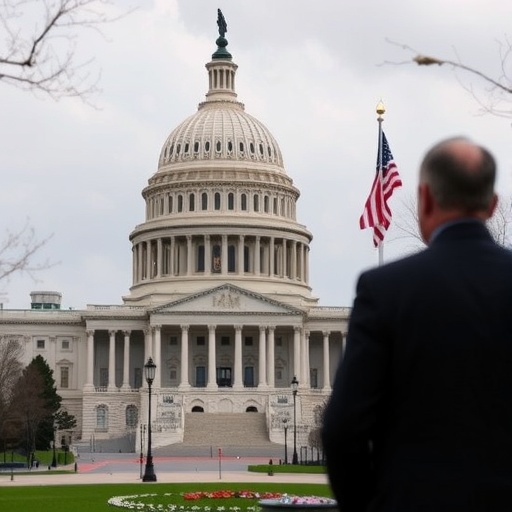Congress Deadlocked on Federal Budget: Government Shutdown Threatens as Deadline Approaches
As the clock ticks down to the September 30 federal budget deadline, Congress remains mired in a bitter stalemate, with lawmakers from both parties digging in their heels over spending priorities. This impasse has ignited widespread fears of a government shutdown, the first since 2019, that could disrupt everything from national parks to federal paychecks for millions of employees. Sources close to the negotiations reveal that talks have broken down multiple times this week, leaving the nation’s fiscal future hanging by a thread.
The drama unfolding on Capitol Hill is not just political theater; it’s a high-stakes battle that could cost the U.S. economy billions. According to a recent analysis by the Congressional Budget Office (CBO), a full shutdown lasting even a week could shave 0.2% off GDP growth in the fourth quarter. With inflation still lingering and the 2024 elections on the horizon, the pressure is mounting for a breakthrough—or a catastrophic failure—in these negotiations.
At the heart of the dispute is the federal budget for fiscal year 2024, which totals over $6.1 trillion. Republicans, holding a slim majority in the House, are pushing for deep cuts to non-defense discretionary spending, aiming to reduce the deficit by at least $2 trillion over the next decade. Democrats, controlling the Senate, counter that such slashes would gut essential programs like education, healthcare, and environmental protection, exacerbating inequality in an already divided nation.
Partisan Lines Harden Over Defense and Social Spending Cuts
The negotiations have hit a wall primarily due to irreconcilable differences on defense versus social spending. House Speaker Mike Johnson (R-La.) has staunchly advocated for increasing military funding to $886 billion, citing rising global threats from China and Russia. “We cannot afford to weaken our defenses at a time when adversaries are emboldened,” Johnson stated during a press conference on Wednesday, emphasizing that any budget deal must prioritize national security.
On the flip side, Senate Majority Leader Chuck Schumer (D-N.Y.) has decried the Republican proposal as unbalanced, arguing it shortchanges domestic needs. “While we support our troops, we can’t build walls around the Pentagon while families at home struggle with food insecurity and crumbling infrastructure,” Schumer remarked in a floor speech. Democrats are insisting on bolstering the social safety net, including an additional $100 billion for Medicaid expansion and $50 billion for clean energy initiatives under the Inflation Reduction Act.
Behind closed doors in the Capitol’s negotiation rooms, tempers have flared. A senior Democratic aide, speaking anonymously, described sessions as “a shouting match where no one budges.” The impasse stems from the FY2023 debt ceiling deal, which capped spending growth but left room for interpretation—room that’s now being fiercely contested. Fiscal conservatives in the House Freedom Caucus have threatened to withhold support unless deeper cuts are made, potentially forcing Johnson to rely on Democratic votes, a move that could fracture his leadership.
Statistics underscore the urgency: The U.S. federal deficit hit $1.7 trillion in fiscal 2023, per Treasury Department data, fueling Republican demands for austerity. Yet, Democrats point to CBO projections showing that unchecked cuts could lead to 1.5 million job losses in the public sector alone if a prolonged shutdown occurs.
Families and Federal Workers Brace for Shutdown Fallout
A potential government shutdown wouldn’t just be a Washington headache—it’s a looming crisis for everyday Americans. During the 35-day shutdown in late 2018-2019, over 800,000 federal workers went without pay, and contractors lost $3 billion in wages, according to the Partnership for Public Service. This time, with more agencies intertwined in daily life, the ripple effects could be even broader.
Consider the human stories emerging from the Beltway. Air traffic controllers, already strained by staffing shortages, fear mandatory furloughs that could ground flights and snarl holiday travel. National Park Service employees, who manage iconic sites like Yellowstone and the Grand Canyon, worry about closures that would devastate local economies reliant on tourism—$44 billion annually, per park service estimates.
“I’ve got bills to pay and a family to feed; another shutdown would be devastating,” said Mark Reilly, a 15-year veteran IRS auditor from Virginia, in an interview with reporters outside the Capitol. Reilly’s sentiment echoes across the workforce: The American Federation of Government Employees estimates that 2.1 million civilians could be affected, with many resorting to food banks or loans to bridge the gap.
Beyond federal workers, Social Security payments might continue via existing funds, but new disability claims could stall, leaving vulnerable seniors in limbo. Veterans’ benefits, processed through the Department of Veterans Affairs, face delays, as seen in past shutdowns when over 10,000 VA staff were furloughed. Economists at the Bipartisan Policy Center warn that consumer confidence could plummet, potentially triggering a broader recessionary signal amid fragile post-pandemic recovery.
- Key Impacts: Furloughs for non-essential personnel across 24 major agencies.
- Economic Hit: Up to $18 billion in lost productivity per week, based on 2019 data adjusted for inflation.
- Long-Term Effects: Delayed IRS tax refunds could inject uncertainty into the spring filing season.
Small businesses, too, stand to suffer. Government contracts, worth $700 billion yearly, might freeze, hitting suppliers in defense, tech, and agriculture. In rural districts, farm subsidies under the USDA could halt, exacerbating the agricultural downturn already felt from weather disasters.
Historical Echoes: Lessons from Past Budget Battles
This isn’t Congress‘ first rodeo with budget brinkmanship. The 2013 shutdown, lasting 16 days, cost $24 billion and eroded public trust, with approval ratings for lawmakers dipping to single digits. More recently, the 2018-2019 episode, the longest in history, stemmed from wall funding disputes and highlighted how partisan polarization can paralyze governance.
Experts draw parallels to today’s negotiations, noting that unified government control isn’t a panacea—divided Congress has led to 20 shutdowns since 1976, per the Pew Research Center. “Each time, the pain is felt by the public, not the politicians who caused it,” said Bill Hoagland, a former Senate Budget Committee staffer now at the Bipartisan Policy Center. Hoagland warns that repeated crises erode institutional credibility, making future deals harder.
Looking back, successful resolutions often hinged on compromises brokered by bipartisan groups like the Gang of Eight. In 2021, under President Biden, a $1.2 trillion infrastructure bill broke a similar logjam, but today’s environment—with midterm scars fresh and 2024 primaries looming—feels more toxic. House Republicans’ slim 221-212 majority means even a handful of defections could doom any bill, forcing reliance on procedural maneuvers like continuing resolutions (CRs).
One silver lining from history: Shutdowns rarely last beyond a month, as political pressure mounts. But with holidays approaching, the timing couldn’t be worse, amplifying the stakes for vulnerable populations.
Bipartisan Voices Call for Compromise Amid Rising Tensions
Amid the deadlock, glimmers of hope emerge from unlikely quarters. Moderate Republicans like Sen. Susan Collins (R-Maine) have urged her party to soften its stance, tweeting, “A shutdown helps no one; let’s find common ground on fiscal responsibility without sacrificing our commitments to the American people.” On the Democratic side, Rep. Hakeem Jeffries (D-N.Y.), the House Minority Leader, has signaled openness to targeted cuts if paired with revenue raisers like closing corporate tax loopholes.
Lobbyists from business groups, including the U.S. Chamber of Commerce, have flooded Capitol Hill with warnings. In a letter to lawmakers, the chamber stated, “Uncertainty from a shutdown would undermine the economic momentum we’ve built, costing jobs and growth at a critical juncture.” Environmental advocates, meanwhile, decry any rollback of green investments, with Sierra Club executive director Jon Evans saying, “Cutting climate funding now is shortsighted and dangerous.”
Behind the scenes, White House officials are shuttling between chambers, with Budget Director Shalanda Young meeting key negotiators daily. President Biden, in a statement from the Oval Office, implored Congress, “Get this done—our nation deserves better than manufactured crises.” Polls from Gallup show 65% of Americans oppose a shutdown, pressuring lawmakers to act.
- Recent Developments: A late-night session on Thursday yielded a tentative agreement on border security funding, but core spending issues persist.
- Stakeholder Pressure: Unions and industry groups ramp up advocacy, with over 500 organizations signing a no-shutdown petition.
- Media Spotlight: Coverage has intensified, with C-SPAN viewership spiking 40% this week.
Yet, hardliners remain unmoved. House Freedom Caucus Chair Bob Good (R-Va.) declared, “No deal without real cuts—America’s future depends on it.” This rhetoric underscores the chasm, but analysts suggest a short-term CR could buy time until after the elections.
Path Forward: Deadline Extensions and Long-Term Fiscal Reforms
As the deadline looms just hours away, eyes are on Speaker Johnson for a potential vote on a continuing resolution to avert immediate disaster. Such a CR would maintain current funding levels into December, allowing more negotiations time. However, conservatives view it as kicking the can, demanding concessions like debt limit hikes tied to spending caps.
Looking ahead, the showdown portends deeper challenges for the federal budget process. With mandatory spending on entitlements like Social Security and Medicare projected to consume 70% of the budget by 2030 (per CBO), lawmakers must grapple with entitlement reforms—a political third rail. Bipartisan commissions, like the Simpson-Bowles model from 2010, could offer blueprints, but implementation requires courage amid election cycles.
If a shutdown does occur, contingency plans include prioritizing payments for debt interest to avoid default, but discretionary services would suffer. The Treasury could invoke extraordinary measures, as in 2023’s debt ceiling saga, but experts like Maya MacGuineas of the Committee for a Responsible Federal Budget caution, “Procrastination only compounds the problem; we need structural changes now.”
For Americans, the message is clear: Stock up on patience and prepare for disruptions. As Congress races against time, the outcome will shape not just this fiscal year, but the trajectory of governance in a polarized era. Whether it’s a last-minute miracle or months of uncertainty, the nation’s fiscal health hangs in the balance, urging lawmakers toward compromise before it’s too late.








